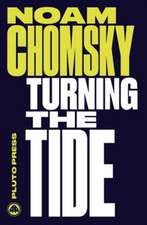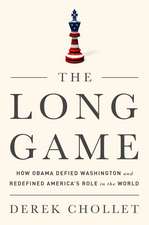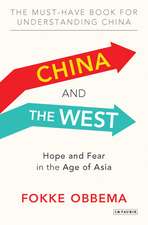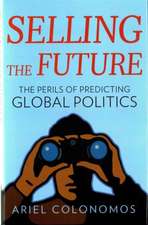The Global Rise of Populism: Performance, Political Style, and Representation
Autor Benjamin Moffitten Limba Engleză Hardback – 31 mai 2016
The Global Rise of Populism argues for the need to rethink this concept. While still based on the classic divide between "the people" and "the elite," populism's reliance on new media technologies, its shifting relationship to political representation, and its increasing ubiquity have seen it transform in nuanced ways that demand explaining. Benjamin Moffitt contends that populism is not one entity, but a political style that is performed, embodied, and enacted across different political and cultural contexts. This new understanding makes sense of populism in a time when media pervades political life, a sense of crisis prevails, and populism has gone truly global.
Preț: 614.94 lei
Preț vechi: 759.19 lei
-19% Nou
117.67€ • 123.11$ • 97.75£
Carte tipărită la comandă
Livrare economică 03-17 aprilie
Specificații
ISBN-10: 0804796130
Pagini: 240
Dimensiuni: 152 x 229 x 18 mm
Greutate: 0.42 kg
Editura: Stanford University Press
Colecția Stanford University Press
Recenzii
Notă biografică
Cuprins
This introductory chapter sets the scene by outlining the rise of populism across the globe over the past two decades, and introducing the key arguments, themes and structure of the book. The chapter makes the case that we need to rethink populism in an age of media saturation, communicative abundance and a wide perception of global crisis. It does this by focusing on populism's position in a shifting media landscape; populism's genuinely global dimension ¿ which moves beyond the Americas and Europe to also take in the Asia-Pacific and Africa; and arguing that populism is not an ideology, strategy, discourse or political logic, but rather a distinct political style comprised of 1) appeal to 'the people' versus 'the elite', 2) 'bad manners', and 3) crisis, breakdown or threat.
This chapter traces the historical development of the term 'populism', tracing its etymological roots from the US Populist Party of the late nineteenth century through populism's conceptual 'journeys' across the twentieth century, before providing a critical overview of contemporary debates about how to define it. It identifies the four central approaches to populism in the current literature ¿ populism as ideology, strategy, discourse and political logic ¿ and outlines the key authors, central arguments and key features of each approach. In doing so, it balances the strengths and weaknesses of these approaches, overall showing that while the features of populism that each approach identifies may be valid ¿ for example, nearly all agree on the centrality of 'the people' versus 'the elite' or some Other ¿ there are problems with the social science categories they use to describe the phenomenon.
This chapter develops the concept of political style as a new way of thinking about populism. Synthesising work on the concept in the fields of rhetoric, political philosophy and political sociology, it defines political style as the repertoires of embodied, symbolically mediated performance made to audiences that are used to create and navigate the fields of power that comprise the political, stretching from the domain of government through to everyday life. It then uses this concept to understand populism. This is done inductively, by examining the cases of 28 populist leaders from around the world, and determining what links them in terms of political style. The three key features of populism thought of in this way are: appeal to 'the people' versus 'the elite'; 'bad manners'; and crisis, breakdown or threat. The chapter then sets out the positive ramifications of using this new conception of populism.
This chapter addresses the specific role of the populist leader as the key 'performer' of contemporary populism. It considers the centrality of leaders within populism, arguing that they should be focused upon above and beyond parties and movements when studying the phenomenon. It then examines how these leaders must negotiate between appearing as both of 'the people' as well as above 'the people' at the same time, balancing performances of ordinariness with extraordinariness. In terms of ordinariness, it looks at populist leaders' 'bad manners' and efforts to distance themselves from 'mainstream' political leaders, focusing on how they flaunt expectations of how politicians are 'supposed' to act. In terms of extraordinariness, it shows how populist leaders present themselves as the embodiment of 'the people', often through performances of strength, health and virility, and how this links with classic notions of the body politic.
This chapter addresses the media as one of the key 'stages' upon which contemporary populism plays out upon. It seeks to answer the following questions: what is the relationship between the media and populism? How do populist actors use media, and how do media cover them? And what have changes in the media landscape, particularly the emergence of new media, meant for populism? In doing so, the chapter examines the links between contemporary populism and the mediatisation of politics, whereby politics is increasingly reshaped and changed as the influence of the media grows. It presents a case for understanding populist actors' nuanced adaption of new media technologies and strategies as a central factor in the spread of the phenomenon, while also reflecting on the role of media control and celebrity within contemporary populism. It finally addresses what the shift from old media to new media has meant for contemporary populism.
This chapter turns to populism's central 'audience' ¿ 'the people' ¿ and investigates the way that populist actors use mediated communication to construct, portray and render-present 'the people' in contemporary populism. It seeks to answer a number of important questions: what processes are involved in speaking for 'the people'? Who are populist performances actually aimed towards? And why do some characterisations of 'the people' gain traction, while others fail? Challenging claims that populism is a 'direct' or 'unmediated' phenomenon, it introduces the concept of mediation in order to better understand these processes. It does this by considering the role of images and media spectacles in presenting 'the people' in contemporary populism; outlining the differences between populist audiences and constituencies when speaking for 'the people'; and explaining how media are never just neutral 'loudspeakers' for populist performances, but actually active participants, often presenting themselves as proxies for 'the people'.
While the received wisdom in the literature on populism is that crisis is a trigger for populism, this chapter offers a new perspective, arguing that we should also consider how populism attempts to act as a trigger for crisis. This is because crisis is never just a neutral or objective phenomenon, but must be performed and mediated by certain actors ¿ something populists tend to do well. Conceptualising crisis as the 'spectacularisation of failure', the chapter shows how populists use crisis to pit 'the people' against a dangerous Other, radically simplify the terrain of political debate; and advocate strong leadership and quick political action. In making this argument, the chapter suggests that we should move from a conception of crisis as something that is purely external to populism, to one that acknowledges the performance of crisis as an internal feature of populism as conceptualised as a political style.
This chapter tackles one of the most controversial debates when it comes to populism: what is populism's relationship to democracy? Arguing that populism itself tells us very little about the substantive democratic 'content' of any political project, the chapter undoes the strict binary between populism and democracy that is often invoked in the literature by instead examining both the democratic and anti-democratic tendencies within populism as conceptualised as a political style. In doing so, it shows that these tendencies can operate concurrently, with populists flaunting their democratic tendencies at the same time as undoing democratic guarantees. Overall, it demonstrates that questions about populism's relationship to democracy should not always be taken at face value, as they often conceal larger questions about what constitutes 'correct' or 'legitimate' forms of political practice.
This chapter draws together the arguments made within this book about populism as a political style and discusses the implications for our understanding of the relationship between contemporary populism, media, crisis and democracy. It shows that contemporary populism should be conceptualised as a distinct political style; that populism cannot be understood without considering the role of media; that crises do not just trigger populism, but that populism attempts to trigger crises; and that populism is a global phenomenon. It also identifies future avenues of research that the book has opened up. It closes by considering the future of populism across the globe ¿ specifically arguing that populism is here to stay as a permanent feature of contemporary democratic politics ¿ and why we need to continue to pay attention to populism's changing shape.












